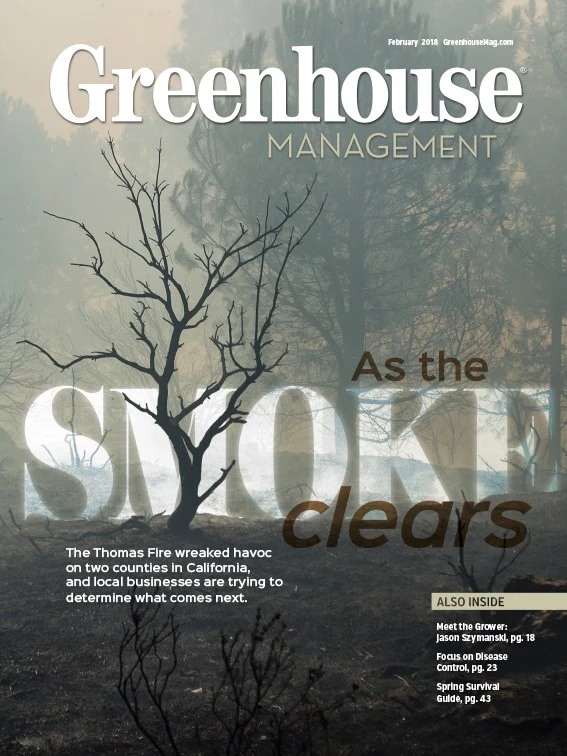
Researchers at the University of Hawaii at Manoa have curbed powdery mildew symptoms in a critically endangered plant via a microbiome transplant. Influenced by human microbiome research, the researchers pureed a wild Hawaiian native plant, Phyllostegia hirsuta, and sprayed the resulting leaf slurry on the leaves of a close relative, the endangered Phyllostegia kaalaensis plant.
The researchers were surprised when they looked closely at the symptom-slashing slurry, because it contained DNA of the same powdery mildew pathogen they were fighting.
“We couldn’t detect any genetic difference between this wild strain of powdery mildew and the one that’s attacking the [plant] — we think it’s the exact same pathogen,” says Dr. Anthony Amend, associate professor of botany at the University of Hawaii at Manoa. Amend conducted the study with Dr. Geoffrey Zahn, a former postdoctoral research associate at UH Manoa who is now an assistant professor at Utah Valley University.
Germs for good
The genus Phyllostegia has only been found on the Hawaiian Islands, according to the study. Out of the 32 recognized species of Phyllostegia, the International Union for the Conservation of Nature lists 14 as critically endangered. This includes P. kaalaensis, which is native to Hawaii’s Waianae Mountains on the island of Oahu, but until recently existed only in two greenhouses — one managed by the State of Hawaii and the other by the U.S. Army.
A variety of factors account for P. kaalaensis’ endangerment, according to Amend. “Disease is one of them, climate change probably has something to do with it, and a lot of their habitats have also been trashed because of developments in Hawaii,” he says. “Range restriction, climate change and disease are probably the one-two-three punch.”
In deciding to introduce beneficial microbes into the plant, the study’s researchers were influenced by a similar discussion about human populations. Amend notes that antimicrobial hand sanitizers and germicidal soaps became popular in the 1990s, but scientists and society have since warmed up to the concept of beneficial germs.
“Kids that are exposed to dogs have a lower prevalence of asthma, for example, and people that are hunter-gatherers have a richer gut flora, and that maybe helps with digestion,” Amend says. “I think we’re probably coming around to some of the same ideas with plants.”

Powdery mildew and the P. plants
The researchers chose to puree the leaves from P. hirsuta because it is a close wild relative of P. kaalaensis and grows in the same range. “The assumption was that it would have a lot of the same fungi — beneficial fungi — growing with it, that Phyllostegia kaalaensis would have,” Amend says.
The researchers chose a healthy P. hirsuta plant, unaware, Amend says, that the powdery mildew pathogen was in the plant. They sterilized the exterior surface of the plant’s leaves, pureed the leaves into a slurry, then inoculated P. kaalaensis’ leaves with the slurry weekly for a total of three weeks, according to the study. The next step was to place a P. kaalaensis leaf infected with powdery mildew in the air intake of P. kaalaensis’ growth chambers.
While researchers lessened powdery mildew in P. kaalaensis using the slurry from the wild P. hirsuta plant, they were unable to achieve the same results using the slurry on a plant relative. “The other part of this story is this sister plant — Phyllostegia mollis — same genus, same issues — this slurry did not work on that plant, for whatever reason,” Amend says. “Same protocols, same methods, same issues, different results.”

Upon reducing powdery mildew symptoms in P. kaalaensis, Amend says the researchers celebrated. “Then we got our data back three months later, and we could actually see what was in that slurry that we had applied,” he says. “It turns out it was full of the powdery mildew.”
Amend theorizes that the powdery mildew in the slurry didn’t cause symptoms because it was part of a larger ecosystem that included a yeast called Pseudozyma aphidis, which produces antagonistic glycolipids and feeds on powdery mildew spores. “Higher P. aphidis abundance was negatively correlated with infection severity,” the study states.
Reintroduction into the wild
A year and a half ago, the healthy P. kaalaensis plants from the study were returned to the Waianae Mountains, and are currently the only plants in the species in the wild, Amend says.
Now, Amend and his colleagues are inoculating plants with mycorrhizae in addition to leaf slurries. They are providing both leaf fungi to knock back powdery mildew, and root fungi to let the plants extract water and nutrients from the soil. These “super plants,” as the researchers call them, will soon be returned to the wild.
As researchers perform more experiments, Amend says, growers should not go spraying their plants with powdery mildew. But they should follow this advice from Amend: “Don’t think of all microbes as germs — some of them are also our friends.”

Explore the February 2018 Issue
Check out more from this issue and find your next story to read.
Latest from Greenhouse Management
- Anthura acquires Bromelia assets from Corn. Bak in Netherlands
- Top 10 stories for National Poinsettia Day
- Langendoen Mechanical hosts open house to showcase new greenhouse build
- Conor Foy joins EHR's national sales team
- Pantone announces its 2026 Color of the Year
- Syngenta granted federal registration for Trefinti nematicide/fungicide in ornamental market
- A legacy of influence
- HILA 2025 video highlights: John Gaydos of Proven Winners





